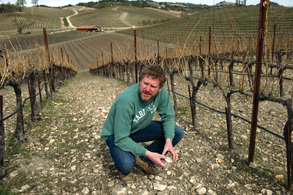 Rain or shine, we're under drought conditions - be good stewards of a precious resource. By Mark Greenspan. (Source Article) Quantification of water relations is key. That means we need to measure things. I’ve been a big fan of plant water status measurements, and you can refer to my previous articles on irrigation for deeper descriptions. The two pieces of plant moisture equipment that I rely on most are the pressure chamber and the porometer. I’ve described both in previous articles, but both are portable instruments that we use primarily during midday to measure plant water status. I find both tools to be indispensable. I only wish there were ways to make those measurements automatically because the short afternoon window, travel time and expense make extensive measurements with those instruments difficult and costly. I am looking at other options for these measurements; but until then, we are getting our money’s worth out of them. Knowing the water stress level of the vine allows us to modify our irrigation regime to dial in specific stress levels in the vines at certain times of the growing season and avoid going overboard with stress, potentially causing crop loss or quality reduction. ... Soil moisture monitoring has also allowed me to reduce the irrigation quantities applied once irrigation cycles begin. By monitoring the total amount of moisture being stored in the soil from an irrigation and then depleted by the vine, I almost always apply between 18 to 22 percent of crop evapotranspiration (Etc) as a maintenance (non-deficit) level. That is far less than is being applied by many growers, who believe that they are “deficit” irrigating at 50 to 60 percent of ETc. I believe the issue with the ETc model, in general, is that it does not account for stomatal pore closure, which occurs in the vines as the season progresses, even without water stress, but is greater (i.e., more closed) under desirable levels of water stress for fine winegrapes. Because I’ve discussed these measurements before and have not changed my practices, I will not go into their use further in this column but rather discuss general practices under drought conditions. ... Drought Management Practices There are many other practices that should be applied during periods of drought. Here is a brief list:
... To me and my certified crop advisor colleagues, irrigating deeper than the root system is a no-no. It not only pushes water past the root zone, where it cannot be taken up, but it also moves nitrate and other potential pollutants (think persistent and mobile pesticides) past the root zone and into the vadose zone (the zone between the root system and the water table). The soluble materials and water are either lost, or they move into the groundwater or in surface or subsurface run-off, all of which will occur in wetter climates. TO READ THE ENTIRE ARTICLE, VISIT WINE BUSINESS MONTHLY.
0 Comments
|
WinStar
|
|
© 2024 WinStar Insurance Group
13625 Ronald W. Reagan Blvd. Building 3, Suite 100 Cedar Park, TX 78613 |
IMPORTANT NOTE: This Web site provides only a simplified description of coverages and is not a statement of contract. Coverage may not apply in all states. For complete details of coverages, conditions, limits and losses not covered, be sure to read the policy, including all endorsements, or prospectus, if applicable. Coverage CANNOT be bound, amended, or altered by leaving a message on, or relying upon, information in this Website or through E-Mail.
Licensed & doing business in the following states only: Texas, New Mexico, & Oklahoma
Licensed & doing business in the following states only: Texas, New Mexico, & Oklahoma

 RSS Feed
RSS Feed


